Mera Peak (6,476m) is the highest trekking peak in Nepal and one of the most rewarding climbs for those seeking their first Himalayan summit. Located in the remote Hinku Valley of the Everest region, Mera offers breathtaking views of five of the world’s highest mountains — Everest, Lhotse, Makalu, Cho Oyu, and Kanchenjunga. The journey to the summit takes you through beautiful forests, traditional Sherpa villages, and remote alpine landscapes, providing both cultural insights and a true wilderness experience.
The climb itself is non-technical but physically demanding due to the altitude and long glacier walk. Basic mountaineering skills, such as using crampons, ice axes, and ropes, are required for the final ascent. Mera Peak is ideal for trekkers with good fitness who want to take their adventure to the next level. It provides a perfect introduction to Himalayan peak climbing without the heavy technical challenges found on higher, more technical summits.
Nature Heaven Treks and Expedition offers a 15-day itinerary carefully crafted to ensure proper acclimatization, safety, and a memorable experience. Our experienced climbing guides provide essential training, support, and encouragement every step of the way. From the scenic flight to Lukla to reaching the summit of Mera Peak, every day on this journey brings a new adventure and stunning Himalayan scenery.
Climbing Mera Peak is more than just reaching a summit—it’s a complete Himalayan experience. Whether you’re an experienced trekker ready to try mountaineering or an adventure seeker dreaming of snow-capped views and high-altitude achievement, this expedition offers the perfect balance of challenge, culture, and beauty.
Mera Peak (6,476m) is considered one of the best options for climbers aiming to summit a Himalayan peak without extreme technical challenges. While the ascent is not highly technical, the climb still demands good physical fitness, endurance, and proper acclimatization. The trekking route to Mera Peak Base Camp passes through remote valleys, forests, and high-altitude terrain, gradually preparing your body for the altitude.
The main difficulty lies in the high elevation and long summit day, which can be physically exhausting. Although fixed ropes and basic mountaineering equipment like crampons, ice axes, and harnesses are used on the final glacier section, technical climbing experience is not strictly necessary. However, having some prior experience with alpine environments or high-altitude trekking is highly recommended to increase your comfort and confidence during the climb.
Weather and temperature also play a significant role in the difficulty of Mera Peak. The conditions at high altitude can be harsh, with cold winds and rapidly changing weather. Climbers must be well-prepared with the right gear and guided by experienced professionals. With proper training, acclimatization, and guidance from a trusted team like Nature Heaven Treks and Expedition, Mera Peak is an achievable and highly rewarding adventure for motivated trekkers.
Mera Peak Climbing is one of the most popular trekking peak adventures in Nepal, standing at 6,476 meters and considered the highest permitted trekking peak in the country. Ideal for beginner climbers with basic mountaineering knowledge, the climb offers a less technical route while still delivering a rewarding high-altitude experience. The trail takes you through beautiful Sherpa villages, dense rhododendron forests, and remote valleys before reaching the Mera Glacier and high camp, offering a perfect blend of cultural immersion and natural beauty.
Nature Heaven Treks and Expedition provides a well-paced 15-day itinerary that ensures proper acclimatization and safety throughout the journey. Our experienced guides offer training and support before the summit attempt, making it suitable even for first-time climbers. The final climb rewards you with panoramic views of Everest, Lhotse, Makalu, Cho Oyu, and Kanchenjunga—five of the world’s highest peaks. Mera Peak is a perfect choice for those aiming to stand above 6,000 meters and enjoy the raw beauty of the Himalayas.
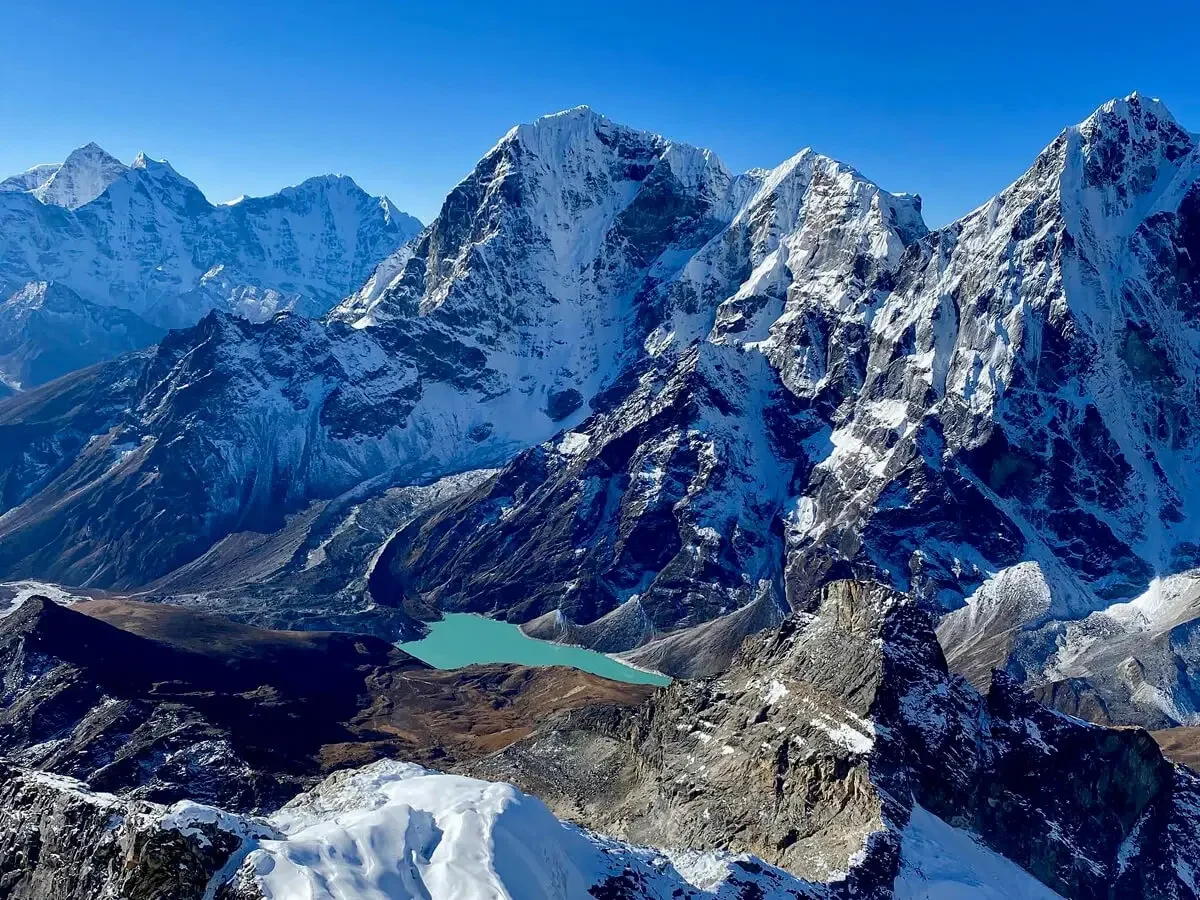
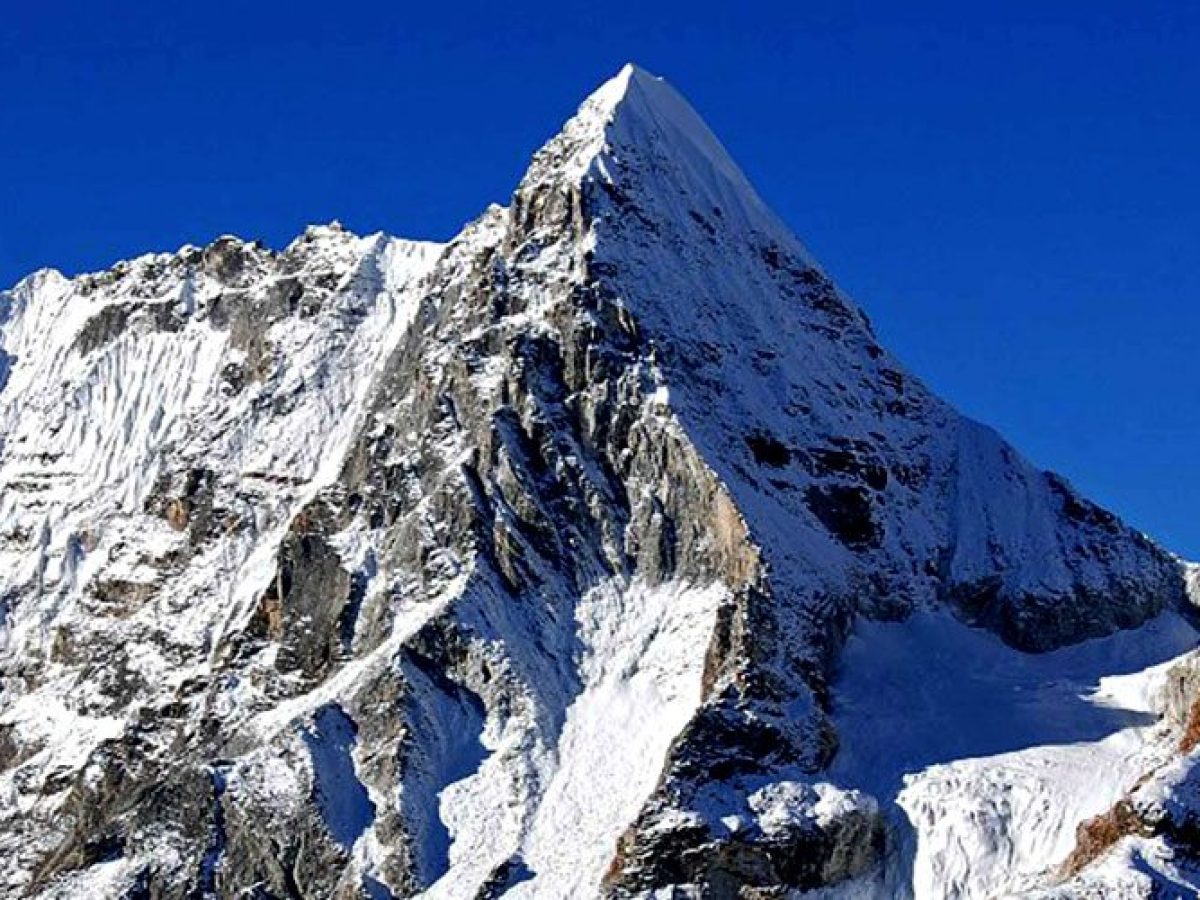

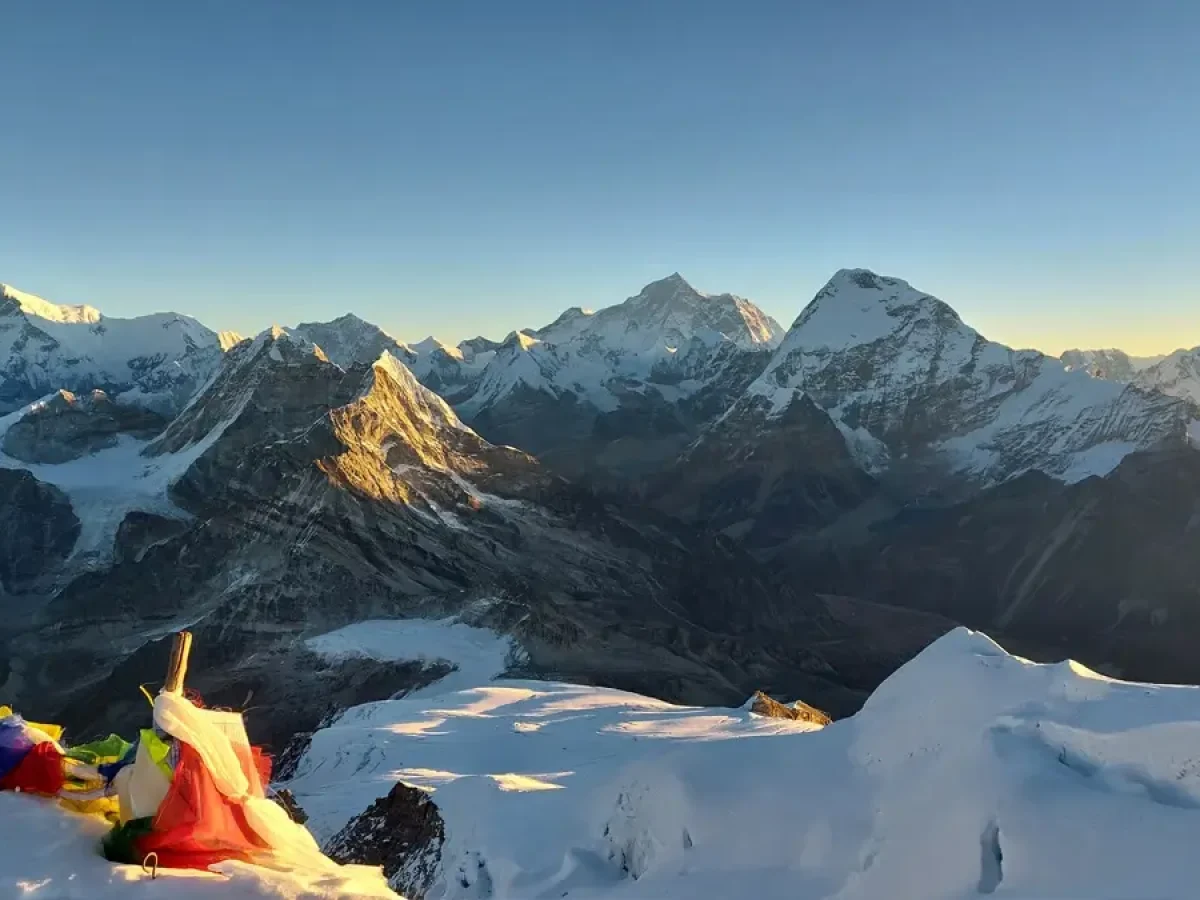
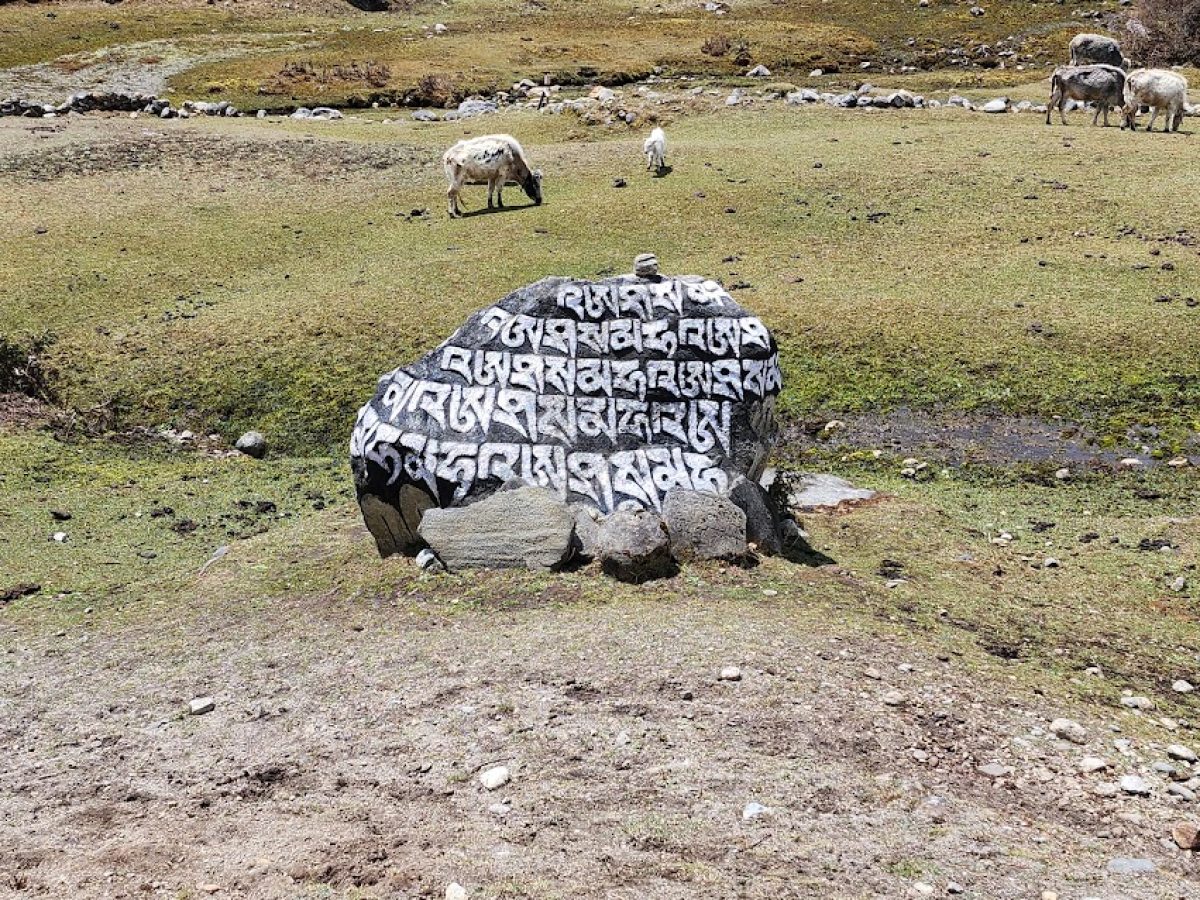


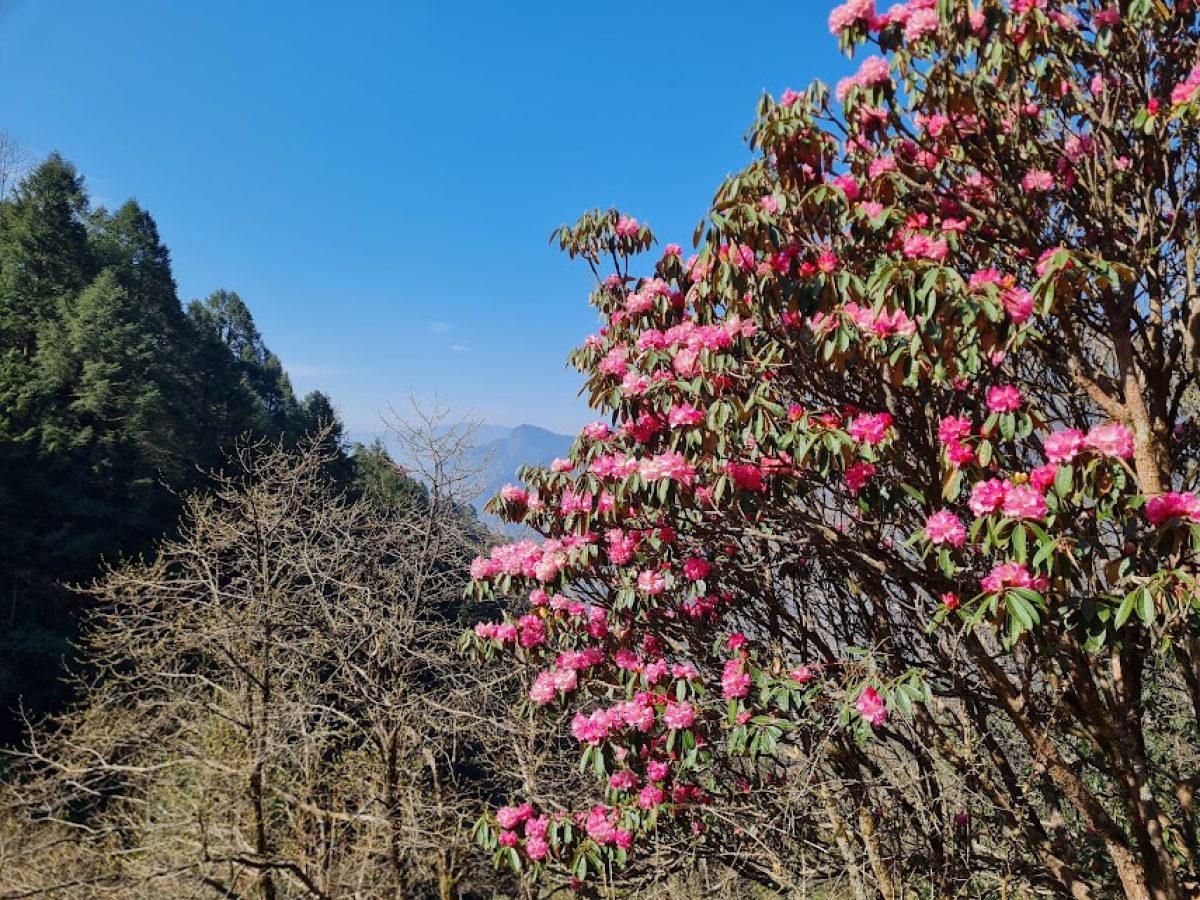

✔️ Private pickup from Tribhuwan International Airport and drop-off at your hotel upon arrival.
✔️ Flight Tickets: Round-trip flight tickets between Kathmandu and Lukla
✔️ Domestic airport hotel Kathmandu
✔️ 3 nights in Kathmandu on a bed and breakfast (BB) basis. 4-5 Star Hotel
✔️ 13 nights in mountain teahouses (twin-sharing), including 2 nights in a dormitory at Mare Peak Climbing Base and High Camp.
✔️ 13 breakfasts, 12 lunches, and 12 dinners during the trek. Meals include traditional dal bhat, noodles, momos, pasta, and soups.
✔️ Purified drinking water (Ef-Chlor water purification tablets) provided throughout the trek.
✔️ Certified, English-speaking trekking guide with first-aid training.
✔️ Certified, English-speaking Climbing guide with first-aid training.
✔️ Assistant guide for groups of 6+ members.
✔️ All staff wages, meals, and equipment covered.
✔️ Required trekking permits for the Everest region.
✔️ Required trekking permits for the Mera Peak.
✔️ All applicable taxes, service charges, and VAT.
✔️ Porter for Luggage Carrying: (each porter can carry up to 25 kg; one porter for two trekkers is recommended).
✔️ All staff wages, meals, and equipment are covered.
✔️ Complimentary Everest trekking map.
✔️ Sleeping bag rated up to -20°C.
✔️ Duffel bag (70–80L) if using porter service.
✔️ First-aid medical kit carried by your guide.
✔️ Free luggage storage during the trek.
✔️ Completion certificate.
✔️ Nature Heaven Treks souvenir T-shirt.
✔️ Farewell dinner in Kathmandu after the trek.
❌ International flights, Nepal visa fees, and personal travel insurance are not included.
❌ Extra costs during the trek, such as hot showers, Wi-Fi, drinks, extra meals, and battery charging.
❌ Any additional nights or meals in Kathmandu beyond what’s included in the package.
❌ Tips for your guide and porter
❌ Any services not specifically mentioned under “Included in the Cost.”
Enjoy complete flexibility with private departures available year-round. You can choose your preferred start date, and we’ll handle all the arrangements. Just use the booking form on the top right to select your date and leave the rest to us.
Once you book, your trip is 100% guaranteed – even if you’re the only one. We don’t cancel based on low enrollment. Every trekker receives the same high-quality service, whether solo or in a small group.
If your plans change, you have options. Cancel at least 30 days before departure for a full deposit refund. If canceling within 30 days, your deposit stays safe with us and can be used to reschedule your trek for any future date that suits you.
Welcome to Nepal!
Upon your arrival at the airport, our friendly team will be there to greet you with a warm smile. Look out for a staff member holding a nameplate with your name at the terminal gate for easy identification. From there, you’ll be comfortably escorted to your hotel.
This marks the beginning of your unforgettable Nepal journey. Once you’ve settled in, feel free to unpack, relax, or explore the vibrant surroundings of your hotel at your own pace.
In the evening, join us for a delightful welcome dinner at a traditional local restaurant. It’s the perfect opportunity to meet your fellow travelers and our team, share stories, and get a taste of Nepalese hospitality.
After dinner, you’re invited to experience the lively energy of Thamel — Kathmandu’s buzzing hub of shops, cafes, and nightlife. Soak in the atmosphere before returning to your hotel for a restful night’s sleep, ready to begin your adventure.
Despite recent earthquakes damaging many architectural gems, Kathmandu Valley’s cultural heritage sites remain enriching. Enjoy a daily tour of 5 UNESCO World Heritage sites: Swayambhunath, also referred to as the “monkey temple”; the historical Durbar Square in Kathmandu, featuring ancient temples and also the chance to work out the living goddess, Kumari; Patan’s Durbar Square; the Hindu temple Pashupatinath; and Bouddhanath, the biggest stupa within the world. A car and driver will escort you to every location, waiting while you explore (note: entry tickets and lunch aren’t included).
After an early morning breakfast, we take a scenic flight from Kathmandu to Lukla (2,730 m), the gateway to the Everest and Mera Peak regions. The 30–35 minute flight offers breathtaking views of the Himalayan range, including glimpses of Everest, Lhotse, and other towering peaks. Upon landing at the Lukla airstrip, we meet our local support crew and begin our trek toward Chutanga, a small settlement nestled within the forested hills below the Zatrawala Pass.
The trek to Chutanga is a short but steady uphill walk through rhododendron and pine forests. As we move away from Lukla, the trail becomes peaceful and less crowded, offering a more serene trekking experience. Chutanga, located at around 3,050 meters, is a perfect stop for acclimatization. We spend the night here, allowing our bodies to adjust gradually to the increasing altitude. The fresh mountain air and natural surroundings provide a refreshing start to our Mera Peak climbing adventure.
After breakfast, we begin our trek from Chutanga, heading towards Thuli Kharka via the Zwatra La Pass (4,600 m). This is a challenging yet scenic day as we ascend through dense forests of rhododendron and pine, gradually making our way to the high alpine zone. The climb to Zwatra La is steep in sections but offers incredible views of the Dudh Kosi Valley and distant peaks. As we reach the pass, prayer flags flutter in the wind, marking this significant crossing point and offering a perfect spot to rest and take in the views.
Crossing Zwatra La, we begin a steady descent toward Thuli Kharka. The trail winds through rocky paths and alpine meadows, with occasional sightings of Himalayan wildlife such as yaks, mountain goats, or colorful pheasants. The landscape opens up as we approach Thuli Kharka, a seasonal grazing area where we’ll spend the night. Surrounded by rolling hills and snow-draped peaks, this peaceful campsite offers a great place to relax and prepare for the days ahead on the way to Mera Peak.
After an early breakfast at Thuli Kharka, we begin our trek toward Kothe. The trail descends gradually through lush rhododendron and pine forests, offering a refreshing contrast to the higher alpine terrain. As we descend, we enjoy beautiful views of the Hinku Valley and surrounding green hills. The path can be rocky and uneven in sections, so we take our time and walk steadily, soaking in the peaceful sounds of nature and occasional wildlife sightings.
The route passes through remote landscapes, with few settlements along the way, giving a true sense of wilderness. After a few hours of trekking, we reach the banks of the Hinku River and continue alongside its flow. As we near Kothe, the landscape opens up, and we start to see small tea houses and resting places. Upon arrival in Kothe, a small village nestled in the valley, we check into a local lodge and enjoy a warm meal. It’s a great place to relax, rehydrate, and prepare for the higher altitudes ahead.
After breakfast at Kothe, we begin our trek towards Thaknak, gradually ascending through the scenic Hinku Valley. The trail follows the west bank of the Hinku River, passing through dense forests of pine, rhododendron, and moss-covered birch trees. As we gain altitude, the landscape becomes more alpine, offering stunning views of Mera Peak and surrounding snow-capped mountains.
This part of the trek is relatively short but important for acclimatization. Along the way, we pass small yak pastures and summer settlements used by local herders. After 3 to 4 hours of trekking, we reach Thaknak (4,350m), a small grazing area with a few tea houses nestled below the towering cliffs of Kusum Kanguru. Upon arrival, we rest, enjoy a warm meal, and take time to explore the surrounding area, allowing our bodies to adjust to the rising elevation.
After breakfast, we begin our trek from Thaknak to Khare, which lies at an elevation of around 5,045 meters. The trail follows the lateral moraine of the Dig Glacier, offering spectacular views of the surrounding snow-covered peaks. As we gradually ascend, the landscape becomes more barren and rugged, showcasing the true alpine beauty of the Hinku Valley. The crisp mountain air and the stunning backdrop of Mera Peak keep us motivated throughout the trek.
The trail from Thaknak to Khare is relatively short but demands a slow and steady pace due to the increasing altitude. We cross several small streams and icy sections, with our guides ensuring a safe passage. Upon reaching Khare, we are welcomed by breathtaking views of Mera Peak looming above. Khare serves as the base camp for Mera Peak, and here we rest, acclimatize, and prepare our gear for the upcoming climb. The village has basic lodges, and the evening is spent relaxing and mentally preparing for the summit push ahead.
After reaching Khare (around 5,000 meters), we take a full day for acclimatization and essential pre-climb training. This rest day is crucial to help your body adjust to the high altitude and reduce the risk of altitude-related illnesses before ascending further. Khare also offers stunning views of Mera Peak and the surrounding glacial landscape, giving you a taste of the adventure that lies ahead.
During the training session, our experienced climbing guides will introduce you to the basic skills required for the summit push. This includes the use of climbing gear such as harnesses, crampons, ice axes, ropes, and ascenders. You’ll practice walking on snow and ice, using fixed ropes, and other essential techniques to ensure you’re confident and prepared for the climb. This preparation at Khare not only boosts your safety but also enhances your overall experience on Mera Peak.
he climb from Khare (4,960m) to Mera High Camp (5,700m) is a crucial part of the Mera Peak expedition, marking a significant altitude gain that prepares climbers for the final summit push. After a restful night in Khare, we begin the ascent early in the morning, trekking through a mix of rocky terrain and moraine slopes. The trail offers stunning views of the surrounding peaks, including Amphu Labtsa and Chukkung Ri, while the air becomes noticeably thinner as we gain elevation. This section requires steady pacing and frequent breaks to help with acclimatization.
The journey to high camp is moderately challenging due to the steepness and altitude but does not require technical climbing skills, making it accessible to fit trekkers with some prior high-altitude experience. Upon reaching Mera High Camp, climbers are greeted with breathtaking panoramic vistas of the Everest, Makalu, Lhotse, and Cho Oyu ranges. The high camp serves as a vital resting point where climbers prepare their gear, rest well, and hydrate in anticipation of the early morning summit attempt, typically scheduled for the next day.
Spending a night at Mera High Camp allows the body to acclimatize further and adjust to the high altitude. The camp itself is simple but comfortable, often set up in tents with essential facilities provided by the expedition team. This strategic stop is key to ensuring climbers are physically and mentally ready for the demanding climb ahead, boosting confidence and safety for the final ascent to Mera Peak’s summit.
From Mera High Camp, the summit push to Mera Peak begins early in the pre-dawn hours to take advantage of firmer snow and safer climbing conditions. The ascent involves navigating steep snow slopes and some glacier travel using crampons and ice axes, so basic mountaineering skills and careful pacing are essential. As you climb higher, the air becomes thinner, making the effort more challenging, but the breathtaking panoramic views of Everest, Lhotse, Makalu, and other Himalayan giants provide incredible motivation.
Reaching the summit of Mera Peak at 6,476 meters is a truly unforgettable achievement, offering stunning 360-degree vistas of some of the world’s highest mountains and vast Himalayan landscapes. After soaking in the spectacular views and taking time to celebrate, you begin your descent back down to Mera High Camp. Descending carefully is important, as fatigue can increase risks on the steep slopes.
Once safely back at High Camp, you rest briefly before continuing the trek down to Khare, a nearby village that serves as a comfortable stopping point. The descent offers a chance to reflect on the climb while enjoying the serene mountain environment. From Khare, the journey continues down through beautiful valleys and traditional Sherpa settlements, completing the rewarding experience of Mera Peak climbing.
The trek from Khare to Kothe marks an important transition as you descend from the high-altitude environment of Khare (around 4,800 meters) toward the lower alpine forests surrounding Kothe. After an early breakfast in Khare, the trail begins with a gradual descent, offering stunning views of the surrounding mountain ranges and glaciers. The path winds through rocky terrain, passing small streams and patches of alpine vegetation, giving trekkers a chance to relax their legs after the demanding climbs.
As you approach Kothe, the landscape becomes greener and more sheltered, with clusters of pine and rhododendron trees replacing the sparse high-altitude flora. Kothe is a peaceful spot nestled among forested slopes, providing a comfortable resting place with tea houses and lodges. The fresh mountain air and scenic surroundings make it an ideal location to recover and prepare for the next stage of the trek. Along the way, you may encounter local wildlife and shepherds tending their yaks, offering a glimpse into the traditional Himalayan way of life.
The journey from Khare to Kothe is a perfect mix of natural beauty and cultural exposure, making it a memorable part of any high-altitude trekking adventure. The moderate descent helps with acclimatization while allowing trekkers to soak in the serene mountain atmosphere before continuing onward.
The trek from Kothe to Thuli Kharka takes you deeper into the heart of the Langtang region, offering stunning natural beauty and a peaceful trekking experience. Leaving Kothe, you will follow a trail that gently ascends through lush forests filled with rhododendron and pine trees. The path is relatively moderate, allowing you to enjoy the fresh mountain air and panoramic views of surrounding peaks as you progress. Along the way, you might encounter local shepherds and their livestock grazing in the meadows, giving you a glimpse into traditional Himalayan rural life.
As you approach Thuli Kharka, the landscape opens up to expansive alpine pastures, known locally as “kharkas,” where yaks and sheep graze during the warmer months. This serene high-altitude meadow offers a tranquil resting spot and an excellent place to acclimatize before continuing to higher elevations. The peaceful atmosphere, combined with breathtaking views of snow-capped peaks, makes Thuli Kharka a favorite stop for trekkers seeking solitude and natural beauty off the beaten path. The night here is crisp and clear, providing an ideal opportunity for stargazing under the vast Himalayan sky.
The trek from Thuli Kharka to Chutanga via Zwatra La (4,600 m/15,092 ft) is a challenging yet breathtaking high-altitude route that takes you across rugged mountain terrain and stunning alpine landscapes. After leaving Thuli Kharka, the trail gradually ascends toward the Zwatra La Pass, offering panoramic views of snow-capped peaks and glacial valleys. The climb to the pass requires steady footing and careful pacing, as the altitude and steep paths test your endurance and acclimatization.
Crossing Zwatra La, you’ll be rewarded with spectacular vistas of surrounding peaks and the remote valleys below. The descent from the pass leads you toward Chutanga, a peaceful mountain village nestled in the lap of the Himalayas. Along the way, you pass through rocky terrain and patches of alpine flora, experiencing the serene beauty and solitude of this less-traveled region. The trek challenges both your physical strength and mental focus, but the stunning scenery and sense of accomplishment make it an unforgettable journey.
The trek from Chutanga to Lukla marks the final leg of your journey through the stunning Everest region, bringing you back to the bustling gateway of the Khumbu. Leaving behind the peaceful and remote landscapes near Chutanga, the trail gradually descends through rhododendron forests and traditional Sherpa villages. As you trek, you’ll enjoy spectacular views of towering peaks like Ama Dablam and Thamserku, alongside glimpses of the Dudh Koshi River flowing alongside the trail.
This section of the trek offers a chance to reflect on your adventure while savoring the changing scenery from high alpine terrain to lower forests and settlements. The trail is well-marked and moderately easy, with gentle ups and downs, making it a comfortable end to your journey. Upon reaching Lukla, you’ll find a lively hub filled with shops, cafes, and lodges, where trekkers from around the world gather. It’s the perfect place to celebrate your accomplishments and prepare for your onward flight back to Kathmandu.
The return to Kathmandu marks the conclusion of the Everest Base Camp trek, with an early morning flight whisking trekkers back to the capital. This flight provides one last aerial view of the magnificent mountains. the rest of the day is at leisure in Kathmandu, with relaxation, indulgence in local cuisine, and shopping. The journey officially concludes with a farewell dinner within the evening, where trekkers receive a certificate commemorating their successful expedition.
Lobuche East Peak Climbing with EBC Trek with Nature Heaven Treks and Expedition concludes today as we ensure your transfer to the international airport from your hotel, coordinating together with your flight point in time. Our commitment to your adventure doesn’t end here; if you have additional days to explore, we’re ready to suggest both adventurous and relaxing trips within Nepal, enriching your experience further.
Please note, that we advise allocating one or two extra days beyond the trek schedule. Flights to and from Lukla are notably weather-dependent, making flexibility in your travel plans a wise precaution to avoid any unforeseen delays.
The best times to trek the Lobuche East Peak Climbing with EBC Trek are spring (March to May) and autumn (September to November). During spring, the trail offers clear mountain views, pleasant temperatures, and blooming rhododendrons in multiple colors. Autumn brings stable weather, clear skies, and exceptional views of Mt. Manaslu and surrounding peaks.
Trekking in winter and monsoon seasons is not advised due to heavy snowfall, closed lodges at higher altitudes, and high landslide risks during the rains.
Although food choices are limited compared to city areas, trekkers can expect healthy, hygienic meals throughout the journey. A typical trek includes 12 breakfasts, 12 lunches, and 11 dinners.
Breakfast options include Tibetan bread, eggs, cereals, pancakes, toast, fruits, and hot drinks.
Lunch and dinner commonly feature dal bhat, vegetable curries, noodles, thukpa, pasta, soups, and snacks. It’s best to eat fresh vegetables, drink plenty of water, and avoid mixing dairy, meat, alcohol, and coffee.
In Kathmandu, you’ll find a wide range of hotels, but along the trek, accommodation is mostly at basic tea houses. Rooms are twin-sharing, often with shared toilets outside the room. Tea houses have a communal dining area with a fireplace. In higher altitudes, it’s essential to carry a warm sleeping bag.
Lobuche East Peak Climbing with the Everest Base Camp (EBC) Trek is considered a challenging adventure, suitable for trekkers with good physical fitness and some prior trekking or climbing experience. The trek involves long walking days, high altitudes, and significant elevation gain. Reaching Everest Base Camp itself is a demanding journey, with altitudes exceeding 5,000 meters, which can lead to altitude-related challenges if not properly acclimatized. The route includes steep ascents, rocky trails, and cold temperatures, especially in the higher sections.
The actual climb to the summit of Lobuche East (6,119m) adds a technical mountaineering element to the trek. Climbers will need to use equipment like crampons, ropes, harnesses, and ice axes, especially on summit day. While it is considered a “trekking peak” by Nepal standards, the final ascent includes steep snow and ice slopes requiring basic climbing skills. With proper acclimatization, preparation, and the guidance of experienced climbing guides from Nature Heaven Treks, this adventure becomes a safe and highly rewarding experience.
Travel insurance is mandatory. It must include emergency evacuation and medical expenses, especially for high-altitude treks. Green Valley Nepal recommends confirming that your insurer covers adventure activities and trip cancellations.
Symptoms can start at elevations above 3,500m and include nausea, headaches, dizziness, and fatigue.
Tips to prevent altitude sickness:
Ascend gradually and allow time for acclimatization
Stay hydrated and avoid alcohol
Consider taking Acetazolamide (Diamox) after consulting a doctor
Descend immediately if symptoms worsen
Rest, use portable oxygen if needed, and never ignore warning signs
Essentials include:
50–70L backpack, sleeping bag, headlamp
Water bottle/purifier, warm clothes, rain gear
Hiking boots, gloves, sunglasses, sunscreen
Quick-dry layers, thermal wear, first aid kit, toiletries
Personal documents, passport, camera, maps, and guidebook
Your safety is a top priority. Nature Heaven Treks and Expedition Nepal’s trained guides carry first aid kits and are equipped to handle emergencies. In case of altitude issues, your trek leader will decide whether to proceed or descend. Emergency helicopter rescue is available if required. The team ensures you trek in a group for added safety.
Nature Heaven Treks is a certified and experienced trekking agency. To book your trek, a 10% deposit is required. You’ll need to provide a copy of your passport, insurance, passport-size photos, and flight details within a week of booking. Payments can be made via online transfer, Western Union, or in person using cash, card, or bank transfer upon arrival in Nepal.
Our team is here to guide you with personalized recommendations, insider advice, and the latest travel updates to make your journey smooth and memorable.
Embark on unforgettable adventures through majestic landscapes, rich cultural sites, and serene natural retreats. Our travel packages are designed to suit every explorer whether you seek thrill, peace, or heritage.
More than 730 individuals and over 50 countries travellers we have deal with
Yael0505
July 21, 2024
“We had an excellent trek with Krishna and his excellent team. The tour itself was excellently planned.”
Wildnature2006,
May 1, 2024
“From the moment we met Krishna at the airport, we knew we were in good hands. Immediately upon arrival…”
Dreamer47485971266,
November 23, 2023
“We had a wonderful time trekking Langtang and the frozen lakes. Krishna has done everything so every…”
Lobuche East Peak Climbing with EBC Trek is moderately to highly challenging. It combines high-altitude trekking with technical alpine climbing. Climbers need good fitness, prior trekking experience, and basic mountaineering skills. The altitude, cold weather, and steep summit push make it suitable for experienced trekkers seeking their first Himalayan peak.
Everest Base Camp Trek, you usually walk for about 5 to 7 hours a day. The duration can vary depending on the trail, altitude, and your pace. Rest days are included for acclimatization to help your body adjust to the altitude.
The best time to trek Everest Base Camp is during spring (March to May) and autumn (September to November). These seasons offer clear skies, moderate temperatures, and stunning mountain views, making the trek safer and more enjoyable for all levels of trekkers.
Why choose Everest Base Camp Trek over other treks?
Iconic Destination: It leads to the base of Mount Everest, the highest peak in the world.
Stunning Views: You’ll see breathtaking Himalayan landscapes, including Everest, Lhotse, and Nuptse.
Rich Culture: The trek passes through Sherpa villages with unique Buddhist culture and monasteries.
Adventure & Challenge: It offers a thrilling mix of physical challenge and natural beauty for all experience levels.
Well-Established Route: Good trekking infrastructure with lodges, tea houses, and guides.
Memorable Experience: It’s a bucket-list trek that offers unforgettable memories and personal achievement.
Packing Recommendations for Everest Base Camp Trek:
Bring warm, layered clothing (thermal wear, fleece, down jacket) for cold temperatures.
Pack sturdy trekking boots and comfortable socks.
Don’t forget a good sleeping bag rated for cold weather.
Carry a daypack for essentials like water, snacks, and a camera.
Bring sun protection: sunglasses, sunscreen, and a hat.
Include a water bottle and water purification tablets.
Take basic toiletries and personal medications.
Use trekking poles to reduce strain on knees.
Pack a headlamp with extra batteries for nighttime.
Keep electronics and documents in waterproof bags.
Why Nature Heaven Treks and Expedition
Nature Heaven Treks offers a variety of trekking options, including popular routes like the Everest Base Camp and Annapurna Circuit, as well as off-the-beaten-path adventures in regions like Manaslu and Langtang .
✅ 17+ Years of Trekking Experience
✅ Certified and Friendly Local Guides
✅ 100% Tailor-Made Itineraries
✅ Small Groups, Big Adventures
✅ Eco-Conscious and Culturally Respectful Practices
✅ 5-Star Reviews from Adventurers Worldwide



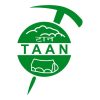


@Copyright 2025 Nature Heaven Treks and Expedition, Kathmandu, Nepal. All Rights Reserved.
Chat with Us